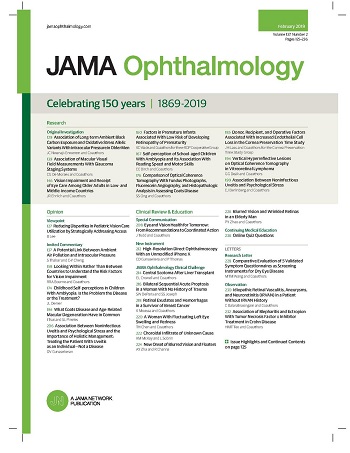莪术营养补充剂与老年性黄斑变性的风险。
IF 7.8
1区 医学
Q1 OPHTHALMOLOGY
引用次数: 0
摘要
重要性姜黄营养补充剂(CBNS)是一种天然的抗炎和抗氧化剂,可能对老年性黄斑变性(AMD)有益。数据收集自汇总电子健康记录研究网络 TriNetX(马萨诸塞州剑桥市)。无老年性黄斑变性的患者在进行倾向得分匹配(PSM)前被纳入研究,其中包括服用和未服用 CBNS 的患者。无 AMD 病史的患者按 CBNS 处方记录的实例进行分层。此外,还根据 CBNS 处方记录实例对有早期非渗出性 AMD 病史的患者进行了分层。主要结果测量罹患非渗出性 AMD、渗出性 AMD、晚期非渗出性 AMD 或地理萎缩 (GA)、失明或需要进行玻璃体内抗血管内皮生长因子 (VEGF) 治疗的相对风险 (RR)。结果 共有 66 804 名服用 CBNS 的患者(平均 [SD] 年龄为 64.9 [10.1] 岁;44 124 名女性 [66.1%])和 1 809 440 名未服用 CBNS 的患者(平均 [SD] 年龄为 67.0 [9.5] 岁;999 534 名女性 [55.2%])被纳入本研究。在 50 岁或以上无 AMD 病史的患者中,使用 CBNS 与非渗出性 AMD(RR,0.23;95% CI,0.21-0.26;P < .001)、晚期非渗出性 AMD 或 GA(RR,0.11;95% CI,0.07-0.17;P < .001)、渗出性 AMD(RR,0.28;95% CI,0.24-0.32;P < .001)、失明(RR,0.46;95% CI,0.36-0.59;P < .001)或需要玻璃体内抗血管内皮生长因子治疗(RR,0.15;95% CI,0.13-0.17;P < .001)。在 60 岁和 70 岁或以上的患者子集中,结果分别一致。在早期非渗出性 AMD 患者中,与没有 CBNS 处方记录的匹配的早期非渗出性 AMD 患者相比,随后的 CBNS 处方记录与较低的晚期非渗出性 AMD 或 GA 发生率相关(RR,0.58;95% CI,0.41-0.81;P < .001)。建议进一步调查以验证这些发现、安全性以及 CBNS 在 AMD 中的潜在药物保护机制。本文章由计算机程序翻译,如有差异,请以英文原文为准。
Curcuma-Based Nutritional Supplements and Risk of Age-Related Macular Degeneration.
Importance
Curcuma-based nutritional supplements (CBNS) are natural anti-inflammatory and antioxidant agents that may confer benefits against age-related macular degeneration (AMD).
Objective
To examine the association between the use of CBNS and the risk of development or progression of AMD.
Design, Setting, and Participants
This was a retrospective cohort study with data collection in June of 2024. Data were gathered from the aggregated electronic health records research network, TriNetX (Cambridge, Massachusetts). Patients without AMD were included in the study before propensity score matching (PSM); these included those taking and not taking CBNS. Patients with no history of AMD were stratified by instances of CBNS prescription records. Patients with a history of early nonexudative AMD stratified by instances of CBNS prescription records were also identified. PSM was performed to control for baseline demographics and medical comorbidities.
Exposures
Patients were stratified by whether or not they were taking CBNS using RxNorm (National Library of Medicine) codes.
Main Outcome Measures
Relative risk (RR) of developing nonexudative AMD, exudative AMD, advanced nonexudative AMD or geographic atrophy (GA), blindness, or requiring intravitreal anti-vascular endothelial growth factor (VEGF) therapy.
Results
A total of 66 804 patients (mean [SD] age, 64.9 [10.1] years; 44 124 female [66.1%]) taking CBNS and 1 809 440 patients (mean [SD] age, 67.0 [9.5] years; 999 534 female [55.2%]) not taking CBNS were included in this study. Among patients without a history of AMD aged 50 years or older, CBNS use was associated with lower rates of developing nonexudative AMD (RR, 0.23; 95% CI, 0.21-0.26; P < .001), advanced nonexudative AMD or GA (RR, 0.11; 95% CI, 0.07-0.17; P < .001), exudative AMD (RR, 0.28; 95% CI, 0.24-0.32; P < .001), blindness (RR, 0.46; 95% CI, 0.36-0.59; P < .001), or requiring intravitreal anti-VEGF therapy (RR, 0.15; 95% CI, 0.13-0.17; P < .001) when compared with matched patients not taking CBNS. Results were consistent among subsets of patients 60 and 70 years or older, respectively. Among patients with early nonexudative AMD, subsequent instances of CBNS prescription records were associated with lower rates of developing advanced nonexudative AMD or GA (RR, 0.58; 95% CI, 0.41-0.81; P < .001) when compared with matched patients with early nonexudative AMD without a CBNS prescription record.
Conclusion and Relevance
Results of this cohort study suggest that a reduced risk of developing AMD or progression to later stages of AMD was associated with subsequent use of CBNS. Further investigation to validate these findings, safety, and potential pharmacoprotective mechanisms of CBNS in AMD are suggested.
求助全文
通过发布文献求助,成功后即可免费获取论文全文。
去求助
来源期刊

JAMA ophthalmology
OPHTHALMOLOGY-
CiteScore
13.20
自引率
3.70%
发文量
340
期刊介绍:
JAMA Ophthalmology, with a rich history of continuous publication since 1869, stands as a distinguished international, peer-reviewed journal dedicated to ophthalmology and visual science. In 2019, the journal proudly commemorated 150 years of uninterrupted service to the field. As a member of the esteemed JAMA Network, a consortium renowned for its peer-reviewed general medical and specialty publications, JAMA Ophthalmology upholds the highest standards of excellence in disseminating cutting-edge research and insights. Join us in celebrating our legacy and advancing the frontiers of ophthalmology and visual science.
 求助内容:
求助内容: 应助结果提醒方式:
应助结果提醒方式:


